Explore the future of our global population dynamics.
January 10, 2025
Written by Turian Biel

Table of Contents
- Global Population Growth Trends Leading to 2025
- Projected World Population Figures for 2025
- Regional Population Growth Patterns
- Impact of Urbanization on Population Dynamics
- Demographic Changes and Aging Population
- Fertility Rates and Their Influence on Population Growth
- Migration Trends Affecting Population Numbers
- Humanitarian Needs Linked to Population Growth
- Environmental Implications of Population Growth
- Future Projections Beyond 2025
- Conclusion: Preparing for a Growing Population
- Further Insights into Global Population Dynamics
- Health Implications of Population Growth
- Education and Population Growth
- Economic Growth and Population Trends
- Technological Advances and Population Management
- Climate Change and Population Growth
- Food Security Challenges Linked to Population Growth
- Water Scarcity and Population Growth
- Social Implications of Rapid Population Growth
- Global Cooperation for Sustainable Population Management
- Future Projections and Their Implications
- Exploring Additional Dimensions of Population Growth
- Gender Dynamics and Population Growth
- Impact of Global Crises on Population Trends
- Role of Non-Governmental Organizations (NGOs)
- Technological Innovations in Agriculture
- Urban Planning for Growing Populations
- Environmental Sustainability and Population Growth
- Public Policy Responses to Population Growth
- Migration Patterns and Their Effects on Population
- Youth Population and Future Growth
- Global Health Initiatives and Population Management
- Additional Considerations in Population Growth Dynamics
- Conclusion
Global Population Growth Trends Leading to 2025
Projected World Population Figures for 2025
The world population is projected to reach approximately 8.5 billion by 2025. This significant increase reflects ongoing demographic trends, particularly in developing regions. The United Nations has highlighted that most of this growth will occur in countries with higher fertility rates, emphasizing the need for sustainable development strategies to accommodate this rising population.
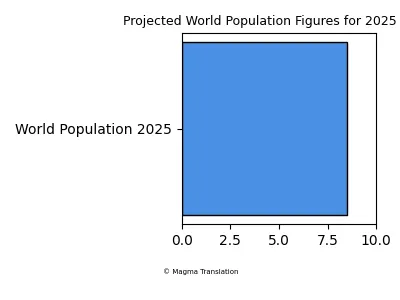
Regional Population Growth Patterns
Different regions will experience varying rates of population growth. For instance, Africa is expected to account for a substantial portion of the global increase, with projections indicating that the continent's population could double by 2050. According to the United Nations, this growth will have significant implications for resource management and economic development.

Impact of Urbanization on Population Dynamics
Urbanization continues to play a crucial role in population dynamics. By 2025, it is estimated that more than half of the world's population will live in urban areas. This shift is driven by the search for better economic opportunities and living conditions. The World Population Review indicates that cities will need to adapt to accommodate the influx of residents, which poses challenges for infrastructure and services.

Demographic Changes and Aging Population
As the global population grows, demographic changes are also occurring, particularly in developed countries. Many nations are experiencing an aging population, which presents challenges for healthcare systems and social services. The United Nations projects that by 2025, the proportion of elderly individuals will increase, necessitating adjustments in policy and planning to support this demographic shift.

Fertility Rates and Their Influence on Population Growth
Fertility rates play a significant role in shaping population growth. In many developing countries, high fertility rates contribute to rapid population increases. Conversely, developed nations are witnessing declining birth rates, which can lead to population stagnation or decline. According to Pew Research, understanding these trends is essential for effective policy-making and resource allocation.
Migration Trends Affecting Population Numbers
Migration is another critical factor influencing population dynamics. Countries experiencing economic growth often attract migrants seeking better opportunities. This influx can significantly alter population figures in both the host and home countries. The Migration Observatory highlights that migration patterns will continue to shape demographic landscapes leading up to 2025.

Humanitarian Needs Linked to Population Growth
As the global population increases, so does the need for humanitarian support. By 2025, it is projected that approximately 305 million people will require humanitarian assistance. This situation underscores the importance of addressing the root causes of crises and ensuring that aid reaches those in need.

Environmental Implications of Population Growth
The environmental impact of population growth cannot be overlooked. Increased population density leads to greater resource consumption and environmental degradation. The Scientific American discusses how sustainable practices must be implemented to mitigate these effects and ensure a balance between population growth and environmental health.

Future Projections Beyond 2025
Looking beyond 2025, the world population is expected to continue growing, with projections indicating a potential peak of around 10.3 billion by 2084. This long-term outlook emphasizes the need for proactive measures to address the challenges associated with such growth, including food security, healthcare, and sustainable development.
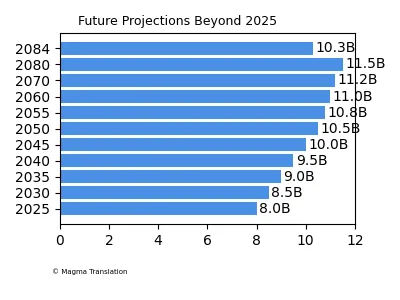
Conclusion: Preparing for a Growing Population
In conclusion, the projected growth of the world population by 2025 presents both challenges and opportunities. Policymakers, communities, and individuals must work together to create sustainable solutions that address the needs of a growing population while preserving the planet's resources for future generations.
Further Insights into Global Population Dynamics
Health Implications of Population Growth
As the world population increases, so do the challenges related to public health. Overcrowding in urban areas can lead to the rapid spread of diseases, straining healthcare systems. The World Health Organization emphasizes the need for robust health infrastructure to manage these challenges effectively, particularly in regions experiencing rapid population growth.
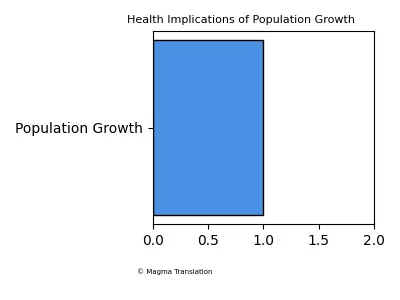
Education and Population Growth
Education plays a crucial role in shaping population dynamics. Higher levels of education, particularly among women, are associated with lower fertility rates. The UNICEF reports that investing in education can lead to more informed family planning decisions, ultimately contributing to sustainable population growth.
Economic Growth and Population Trends
Population growth can drive economic development, but it can also strain resources if not managed properly. Countries with a growing workforce can benefit from increased productivity, but they must also ensure that there are enough jobs and resources available. The World Bank highlights the importance of creating economic opportunities to harness the potential of a growing population.
Technological Advances and Population Management
Technological innovations are essential for managing the challenges posed by population growth. Advances in agriculture, healthcare, and urban planning can help accommodate larger populations sustainably. According to MIT Technology Review, leveraging technology can enhance resource efficiency and improve living conditions in densely populated areas.
Climate Change and Population Growth
The relationship between population growth and climate change is complex. More people can lead to increased greenhouse gas emissions and resource depletion. The Intergovernmental Panel on Climate Change warns that without significant changes in consumption patterns, the growing population will exacerbate climate-related challenges, necessitating urgent action to mitigate impacts.
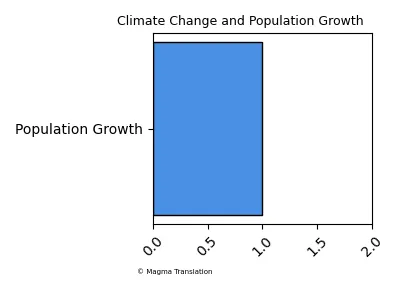
Food Security Challenges Linked to Population Growth
As the population grows, ensuring food security becomes increasingly challenging. The demand for food is expected to rise significantly, putting pressure on agricultural systems. The Food and Agriculture Organization emphasizes the need for sustainable agricultural practices to meet the nutritional needs of a growing population while minimizing environmental impact.
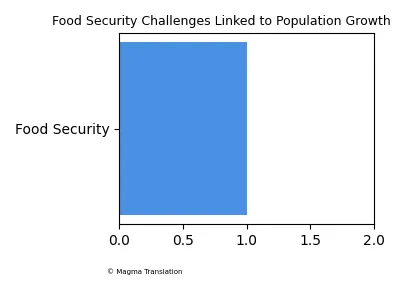
Water Scarcity and Population Growth
Water scarcity is a pressing issue linked to population growth. Increased demand for water resources can lead to conflicts and shortages, particularly in arid regions. The United Nations Water reports that effective water management strategies are essential to ensure access to clean water for all, especially as populations continue to rise.
Social Implications of Rapid Population Growth
Rapid population growth can lead to social tensions and challenges, particularly in areas where resources are limited. The United Nations Chronicle discusses how addressing social inequalities and ensuring equitable access to resources is crucial for maintaining social cohesion in rapidly growing populations.
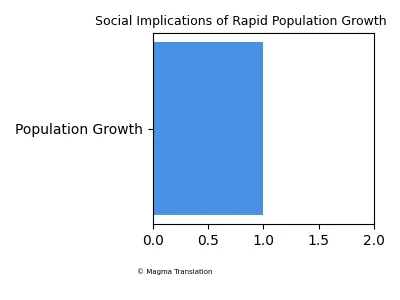
Global Cooperation for Sustainable Population Management
Addressing the challenges of population growth requires global cooperation and collaboration. International organizations, governments, and communities must work together to develop and implement policies that promote sustainable development. The United Nations emphasizes the importance of collective action in managing population dynamics effectively.
Future Projections and Their Implications
Future projections indicate that the world population will continue to grow, with estimates suggesting it could reach around 10.3 billion by 2084. Understanding these trends is vital for planning and preparing for the implications of a larger global population.

Exploring Additional Dimensions of Population Growth
Gender Dynamics and Population Growth
Gender dynamics play a significant role in shaping population trends. Empowering women through education and access to reproductive health services can lead to lower fertility rates and improved family planning. The United Nations Population Fund emphasizes that gender equality is crucial for sustainable population growth and development.

Impact of Global Crises on Population Trends
Global crises, such as pandemics and conflicts, can significantly impact population trends. The COVID-19 pandemic has led to changes in birth rates and migration patterns worldwide. According to Brookings Institution, understanding these shifts is essential for future population projections and policy planning.
Role of Non-Governmental Organizations (NGOs)
Non-governmental organizations (NGOs) play a vital role in addressing the challenges associated with population growth. They often provide essential services, such as education and healthcare, particularly in underserved communities. The Oxfam highlights the importance of NGO involvement in promoting sustainable development and population management strategies.

Technological Innovations in Agriculture
Technological advancements in agriculture are crucial for meeting the food demands of a growing population. Innovations such as precision farming and genetically modified organisms (GMOs) can enhance crop yields and sustainability. The Food and Agriculture Organization discusses how these technologies can help ensure food security in the face of increasing population pressures.
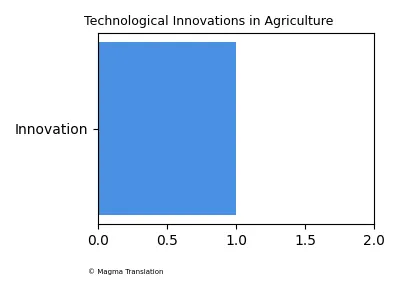
Urban Planning for Growing Populations
Effective urban planning is essential for accommodating growing populations in cities. As urban areas expand, planners must consider infrastructure, housing, and transportation needs. The United Nations emphasizes the importance of sustainable urban development to create livable cities for future generations.
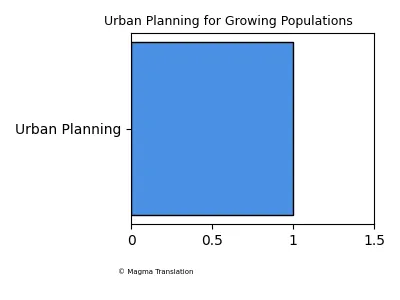
Environmental Sustainability and Population Growth
Population growth poses significant challenges to environmental sustainability. Increased consumption of resources can lead to habitat destruction and biodiversity loss. The World Wildlife Fund highlights the need for sustainable practices to balance human needs with environmental conservation.
Public Policy Responses to Population Growth
Governments must develop effective public policies to address the challenges of population growth. This includes investing in education, healthcare, and infrastructure. The OECD provides insights into how policy frameworks can support sustainable population management and development.
Migration Patterns and Their Effects on Population
Migration patterns significantly influence population dynamics. Economic opportunities, conflicts, and climate change drive people to migrate, impacting both sending and receiving countries. The International Organization for Migration discusses how understanding these patterns is essential for effective population policies.
Youth Population and Future Growth
The youth population is a critical factor in future population growth. Countries with a large proportion of young people may experience rapid population increases. The United Nations emphasizes the importance of investing in youth education and employment to harness their potential for sustainable development.
Global Health Initiatives and Population Management
Global health initiatives are vital for managing population growth and improving health outcomes. Access to healthcare services, vaccinations, and maternal health programs can significantly impact population dynamics. The World Health Organization highlights the importance of comprehensive health strategies in addressing the challenges posed by a growing population.

Additional Considerations in Population Growth Dynamics
Climate Migration and Population Shifts
Climate change is increasingly becoming a driver of migration, as people are forced to leave their homes due to extreme weather events and rising sea levels. The United Nations reports that millions may migrate in search of safer living conditions, leading to significant shifts in population distribution and increased pressure on urban areas.
Food Production Innovations for a Growing Population
Innovations in food production are essential to meet the demands of a growing global population. Techniques such as vertical farming and aquaponics are gaining traction as sustainable solutions. The Food and Agriculture Organization emphasizes the importance of reducing food waste and improving production efficiency to ensure food security for all.

Role of International Aid in Population Management
International aid plays a crucial role in supporting countries facing challenges related to population growth. Aid can help improve healthcare, education, and infrastructure in developing nations. The OECD highlights how targeted assistance can empower communities to manage their population dynamics effectively.
Public Awareness and Education on Population Issues
Raising public awareness about population issues is vital for fostering informed discussions and actions. Educational campaigns can help communities understand the implications of population growth and the importance of sustainable practices. The Population Education initiative focuses on providing resources to educate individuals about population dynamics and their impact on the planet.
Conclusion
In summary, the projected growth of the world population by 2025 presents a complex array of challenges and opportunities. Addressing these issues requires a multifaceted approach that includes sustainable development, effective public policies, and global cooperation. By understanding the dynamics of population growth and its implications, we can work towards a more sustainable and equitable future for all.
